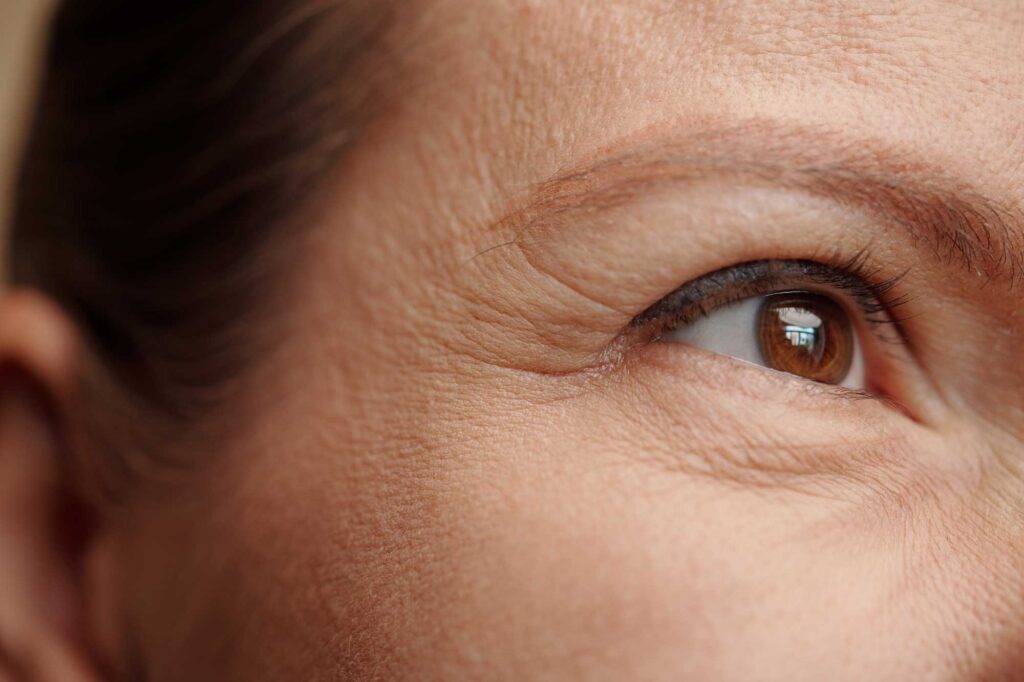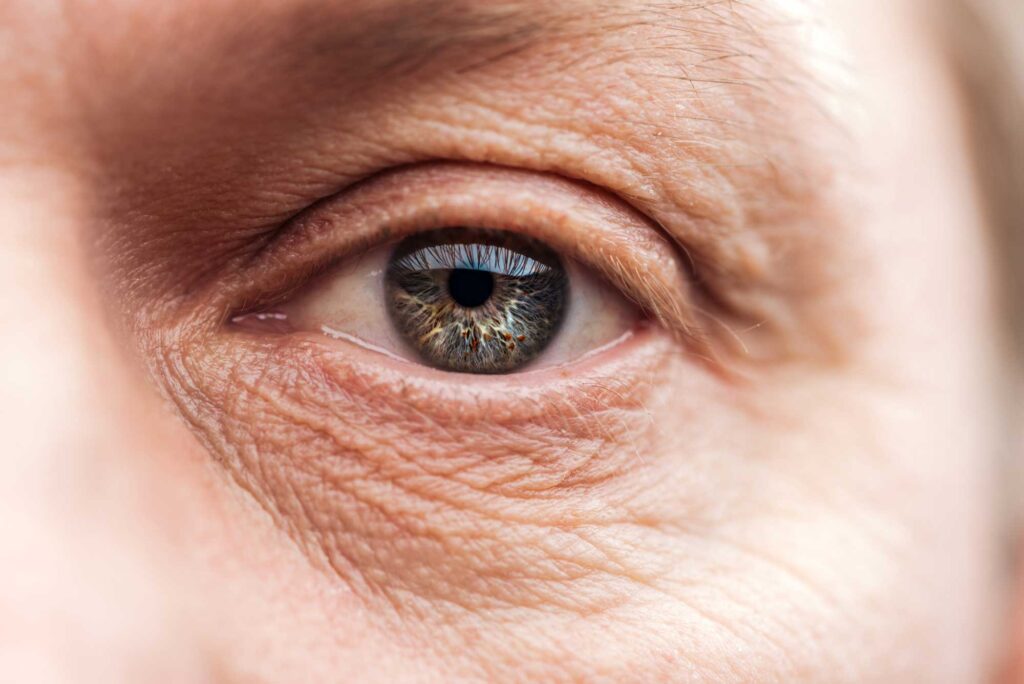Reviva Labs, Skin Care
How to Treat and Prevent Under-Eye Wrinkles
The skin around the eyes is delicate. It’s thinner than the rest of the face, which makes it more prone to showing signs of aging. Crow’s feet, fine lines, and crepey texture can appear even when the rest of your skin is relatively smooth. But the good news is that under-eye wrinkles aren’t inevitable—and if you’re already seeing them, they can be softened. With consistent care, smart product choices, and a few lifestyle tweaks, you can make a visible difference in how your eye area looks and feels.
Why Under-Eye Wrinkles Form So Easily
Several factors work against this part of the face. First, the skin under the eyes lacks sebaceous (oil) glands. That means it dries out faster, especially when environmental conditions are harsh, or your skincare routine isn’t hydrating enough. Second, the area is in constant motion. Every time you squint, smile, or rub your eyes, you’re contributing to wear and tear. Over time, this leads to expression lines and skin laxity.
Collagen loss also plays a major role. After your mid-20s, your body begins to produce less collagen each year. That natural decline affects skin elasticity and thickness, so lines can form and deepen. Add in external stressors like UV exposure, pollution, lack of sleep, or high sugar consumption, and you’ve got a perfect storm for premature wrinkles.
The Role of Hydration
One of the fastest ways to make under-eye wrinkles more visible is to let your skin get dehydrated. Fine lines can look deeper and more pronounced when moisture levels drop. That’s why applying a targeted eye product with humectants—like hyaluronic acid or glycerin—can give a quick plumping effect.
But hydration shouldn’t stop at skincare. Drinking enough water throughout the day is just as critical. If you’re not getting at least eight cups of fluids daily (and more if you consume caffeine or alcohol), your skin will show it. Dehydrated skin isn’t just dry—it can also become flaky, irritated, and more prone to wrinkling.
Treating Existing Under-Eye Wrinkles
If lines have already made themselves at home around your eyes, don’t worry. While you can’t turn back time, you can improve texture and firmness with the right routine.
Start with gentle exfoliation. Even though the eye area is fragile, it can benefit from occasional sloughing to remove dead skin cells and encourage renewal. Use enzyme-based exfoliants or products specifically formulated for use around the eyes. Avoid anything gritty or too acidic.
Next, focus on ingredients that support collagen production and cell turnover. Retinol is one of the most effective options, but it must be used carefully around the eyes. Look for eye creams with microencapsulated or time-release retinol that offer low irritation. Start by applying it every third night, then gradually increase as tolerated.
Peptides are another valuable ally. These small chains of amino acids can signal the skin to produce more collagen and elastin. They’re generally well-tolerated and suitable for long-term use. Niacinamide (vitamin B3) is also helpful—it improves barrier function and brightens the skin, which can reduce the appearance of dark circles that make wrinkles more noticeable.
Antioxidants round out the treatment picture. Vitamin C is a gold-standard choice, known for brightening, smoothing, and protecting skin from free radical damage. A daily antioxidant eye cream can help guard the area against further breakdown of collagen while making skin look more luminous.

Preventing Future Wrinkles
Daily habits make a difference. Sun exposure is a top contributor to under-eye aging. Even short bursts of UV light can damage collagen and elastin fibers, leading to thinning and wrinkling. Always wear a broad-spectrum SPF—even on cloudy days—and don’t forget to apply it gently around the eye area. Wearing sunglasses with UV protection can reduce squinting and provide another layer of defense.
Sleep position matters, too. If you press your face into the pillow every night, that mechanical pressure can encourage fine lines to form. Try sleeping on your back, and consider switching to a silk pillowcase, which creates less friction on the skin.
Eye strain can also lead to wrinkles. Staring at screens for hours on end without breaks may cause you to squint or tense your facial muscles unconsciously. Make it a habit to follow the 20-20-20 rule: every 20 minutes, look at something 20 feet away for at least 20 seconds. This gives your eyes a rest and can reduce tension around the sockets.
Finally, manage stress. Chronic stress increases cortisol, which breaks down skin’s support structures over time. Meditation, breathwork, regular exercise, or even a daily walk outdoors can all help lower stress hormones and support healthier skin aging.
The Importance of Consistency
Quick fixes don’t work when it comes to under-eye care. In most cases, you’re playing the long game—and consistency is everything. Even the most effective ingredients won’t do much if they’re only used occasionally. Build a routine you can stick to and be patient. Visible improvements can take 6 to 12 weeks of steady use, depending on the severity of the wrinkles and the condition of your skin.
Morning and evening routines should be slightly different. In the morning, apply a lightweight hydrating eye cream with antioxidants, followed by sunscreen. At night, layer on a more nourishing product with actives like retinol or peptides, giving it time to absorb before lying down.
Professional Treatments That Help
If topical skincare isn’t getting you the results you want, professional options can amplify your efforts.
Microneedling is one of the most popular choices for addressing fine lines. It works by creating controlled micro-injuries that trigger collagen production. When done under expert supervision, it’s safe even for the under-eye area.
Laser treatments like fractional CO₂ or non-ablative resurfacing can also improve texture and firmness. These options typically require some downtime but offer longer-lasting results.
Injectables like Botox can soften dynamic wrinkles caused by repeated muscle movement. When used conservatively, Botox around the crow’s feet can create a smoother appearance without freezing your natural expressions.
Fillers are another possibility, especially for hollow under-eyes. Hyaluronic acid-based fillers can plump the skin, making lines less prominent. However, this is a delicate area, so it’s important to choose an experienced injector who understands facial anatomy.
Ingredients Worth Adding to Your Routine
When shopping for eye treatments, it helps to know what to look for on the label. These ingredients have proven track records in smoothing and supporting the under-eye area:
- Hyaluronic Acid – draws moisture into the skin, plumping lines
- Peptides – help rebuild collagen and improve firmness
- Retinol – encourages skin turnover and smooths texture
- Caffeine – reduces puffiness and may tighten the skin temporarily
- Vitamin C – brightens, firms, and protects against oxidative damage
- Ceramides – support the skin barrier and reduce moisture loss
- Niacinamide – improves tone, strengthens the skin, and reduces inflammation
Keep in mind that more isn’t always better. A simple formula with a few powerful ingredients is often more effective than something overloaded with actives.

What to Avoid
Certain habits and products can do more harm than good. Over-applying products, rubbing or tugging at the skin, or using harsh cleansers can break down the delicate skin around your eyes. Always use a light touch and pat creams in with your ring finger to minimize pressure.
Fragrance is another potential irritant. Because the under-eye area is sensitive, it’s better to stick with fragrance-free products to reduce the risk of inflammation or allergic reactions.
Also be cautious with makeup removal. Rubbing at waterproof mascara or long-wear eyeliner can cause unnecessary trauma. Use a gentle, oil-based remover that dissolves makeup without needing to scrub.
When to Start an Eye Care Routine
It’s never too early—or too late—to start caring for your under-eye area. Prevention should ideally begin in your mid-20s, when collagen production naturally starts to slow down. But even if you’re dealing with existing wrinkles, you can still make a noticeable impact with the right products and habits.
Don’t wait for deep lines to appear before taking action. Even small changes—like using SPF, staying hydrated, and wearing sunglasses—can pay off over time. Think of eye care as an investment in your future appearance and comfort.
The Connection Between Lifestyle and Skin Aging
There’s a strong link between overall health and skin condition. What you eat, how much you sleep, how well you manage stress—it all shows on your face. Diets rich in processed foods and sugars can accelerate skin aging by promoting glycation, a process that weakens collagen fibers.
Aim for a diet high in antioxidants, healthy fats, and hydration. Omega-3s from sources like flaxseed, chia, or salmon help maintain the skin’s lipid barrier, which is crucial for keeping the under-eye area smooth. Leafy greens, berries, and citrus fruits support collagen and fight free radical damage.
Smoking is another big offender. It restricts blood flow and depletes nutrients essential for skin repair. Quitting smoking can dramatically slow wrinkle formation and improve your skin’s tone and texture.
Sleep is equally important. Skin repairs itself overnight, so short-changing your rest means missed opportunities for regeneration. Try to get at least 7–9 hours per night and keep electronics out of the bedroom to improve sleep quality.
Final Tips for Softer, Smoother Eyes
- Always remove your makeup before bed.
- Store your eye cream in the fridge for a cooling, de-puffing boost.
- Apply products with your ring finger—it’s the weakest and least likely to cause damage.
- Don’t skip sunscreen, even if you’re indoors most of the day. UV rays can penetrate windows.
- Be gentle when drying your face. Pat, don’t rub.
- Invest in quality, not quantity. One great eye cream is better than a drawer full of half-used products.
Eye Area Care Is a Lifelong Commitment
There’s no one-size-fits-all fix for under-eye wrinkles. But small steps add up. Whether you’re starting early or playing catch-up, caring for your eyes with intention can lead to visible improvements and help you feel more confident in your skin. And while the goal isn’t perfection, maintaining a smooth, nourished eye area can help you look and feel refreshed—no matter your age.











